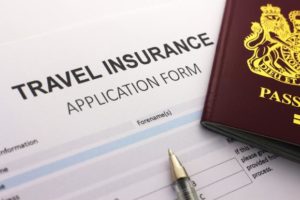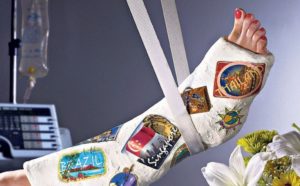
Picture source: Google
A couple of months ago, I wrote about the Society of Aeromedicine Malaysia (SAMM) and highlighted some of the activities and critical transport of patients that the society has done, both locally and abroad. Since its publication, I’ve received a lot of questions about the entire process of medical evacuation or repatriation. Before I cover that in a separate article, let me briefly cover some things to consider whenever you are travelling overseas whether for work or pleasure.
First and foremost – travel insurance. The idea of spending money on something that you might not utilise, unfortunately, causes many to overlook it. Many would rather spend the extra hundred ringgit on souvenirs or gifts. While most airlines have a travel insurance option when you purchase their tickets, it is not mandatory. Travellers can still decide not to take up the insurance and proceed to order their in-flight meal of nasi lemak instead.
I have seen enough people regretting that decision. Do not make the same mistake! If you are uncomfortable with the insurer that underwrites the insurance offered, go to an independent travel insurance site and make your purchase. Many major insurance firms make it easy to buy and print your policy directly online.
Once you have purchased your travel insurance, make sure your travelling companion or your family has a copy of the policy. I personally send a copy to my wife via email so that she can access it easily. Do not be discreet about it; when you have a head injury and are lying unconscious, you cannot be the one doing all the paperwork.
Notify the travel insurance company as soon as possible so that you get immediate assistance. I previously worked for a large insurance company and was amazed by the mechanisms these companies have set up for clients in need. There is a huge team of experienced travel assistance coordinators fluent in multiple languages as well as certified medical personnel who are assuring and comforting. This is very helpful when you are alone in unfamiliar places, especially when faced with difficulties communicating with local doctors or authorities. Trust me when I say that you will not regret involving them from the start.
Does travel insurance cover everyone for everything? Unfortunately, no. There are certain limitations and exclusions included in most travel insurance policies. For example, the age limit for coverage is usually not more than 70 years. A few policies are known to cover up to the age of 79, but be sure to read the fine print. Many policies do not cover pregnancy and pregnancy-related illnesses, emergency delivery of a preterm baby, alcohol- or drug-abuse related injuries, as well as injuries related to high-risk sports activities like base jumping. However, the average leisure traveller should have no issue being covered if claims are genuine.
So what options do travellers have other than travel insurance? The following are some practical tips:
- The most important thing to consider is whether you are fit to travel in the first place. You may have a bucket list to tick off, but you must be realistic too. It is best to speak to someone of a similar age or medical condition who has been to where you want to go, and learn from their experience. Speak to your doctor before travelling if you need to.
- Anticipate the possibility of emergencies and always have a “worst case scenario” action plan on hand. You don’t have to spend hours mapping out an evacuation plan – that is best left to the experts – but keep in mind what to do when something unexpected happens.
- Allow for adequate travel time. Many people plan multi-city trips in the space of a few days, travelling long distances without allowing their body enough time to rest. This is not advisable if you have health concerns.
- Be aware of the physical challenges you may face. I have dealt with many who travelled to high-altitude areas in China, Tibet, Nepal and Peru but did not give themselves enough time to acclimatise to the change in altitude. They ended up with altitude sickness which required emergency evacuation to lower ground.
- Be mindful of the areas that you are travelling to as major hospitals may be located hundreds of kilometres away. Rugged terrain and bad weather can further delay medical attention.
In a nutshell – plan, plan, plan! Encourage your travel companions to take the same precautions to protect themselves.

Pic source: Google
So what if, despite the best planning, something happens and you are not insured? Firstly, a prayer won’t hurt if you are religiously inclined. Secondly, call for help. You are not alone and there will be many who will get you the necessary assistance. Funding emergency medical expenses and medical evacuation and/repatriation will be a challenge. Start a donation drive among your family and friends, set up a crowdfunding website, liquidate some assets, apply for a personal loan, and so on. Malaysians are generally helpful and will come to the aid of a fellow citizen in need of help. Government officials are able to help in a limited capacity, but financial assistance is not a straightforward process and may not progress as expected.
Negative thoughts and statements like “Why did they travel when they’re pregnant/sick/old?” are hardly helpful in these situations. No one plans a trip only to be taken ill or injured, confined to a hospital bed in a foreign country while on holiday. At the very least, a prayer or some words of encouragement should be given to the travellers and their families.
In the end, the million-ringgit question remains: What is the most painless way for medical repatriation and evacuation of the many citizens who are stranded overseas, without causing financial ruin to their families? Well, SAMM has offered our services and assistance to the powers that be. However until such time that our recommendations are taken on board by the relevant parties, unfortunately travellers and their families will continue to bear the burden.
Dr Gunalan is the Vice President SAMM and Consultant Anaesthesiologist and a Critical Care Physician.
[This article belongs to The Malaysian Medical Gazette. Any republication (online or offline) without written permission from The Malaysian Medical Gazette is prohibited.]
